|
|
GO BACK TO THE 10 KYU PAGE (ORANGE BELT)
9 KYU - ORANGE BELT/BLUE STRIPE
|
|
Here you will find all of the information that you will need to prepare you for your grading. This information includes your theory and your practical test. I hope this information helps you in giving you a better understanding about Kyokushin Karate and also gives you a better understanding of your requirements and at the same time helps you to study and prepare for it.
MEANING OF THE BELTS
Below you will find a possible interpretation of the symbolism of the belt colors. I hope this will give a further understanding the sense in which the Obi (belts) colors mean. Belts colors are not only to reflect growth in technique, but also in character.
The Orange
Belt (Adaptability)
At this level the orange belt represents
the
stability that we should bring to our training as well as in our life. On this level
you will begin developing a sense of balance and coordination between the
various parts of your body, with an emphasis to perform your stances correctly.
At this level the students will be given emphasis to the correct execution of
the kihon geiko. Learning the correct way of executing the techniques will give
the students a good foundation that will give them a cutting edge on later
stages of his learning process of the Martial Arts.
Learning to execute the different techniques correctly will require from the
students a lot of work and repetitions of those techniques. The student must
have a constant devotion in order to persevere and continue training with
receptivity and dedication.
![]()
WHAT YOU SHOULD KNOW FOR YOUR
KYOKUSHIN THEORY TEST
9 KYU - ORANGE BELT/BLUE STRIPE
Below are some vocabulary you should be able to know in order to do your grading.
|
vocabulary |
|
|
Name |
Meaning |
| Uraken Sayu Uraken Sayu Uchi Shita Shita Tsuki Hiji Ate Jodan Hiji Ate Chudan Hiji Ate Shuto Ganmen Shuto Ganmen Uchi Soto Uchi Mawashi Seiken Chudan Uchi Uke Seiken Chudan Soto Uke Uchi Mawashi Geri Soto Mawashi Geri Kokutso Dachi Musubi Dachi Kiba Dachi Kiba Dachi Kamae Nogare Sanbon Kumite Ippon Kumite Obi Mokuso Yonjugo Yonjugo-do Kyuju Kyuju-do Heisoku Haisoku Teisoku |
Back fist Left and right Back fist strike left and right Lower / Underneath / Low angle Strike to lower abdomen Elbow Strike (another word we use for strike with elbow)) High Elbow strike Middle Elbow strike Knifehand or Handsword Face Knifehand to the face Outside Inside / Strike roundhouse Middle Inside block Middle Outside block Inside roundhouse kick Outside roundhouse kick Back leaning stance Meditation stance. Heels touching, feet make a `V' shape. Horse or straddle stance Horse or straddle stance sparring stance Deep breathing exercise Three Step Sparring One Step Sparring Belt Mental relaxation or Quiet Mind 45 (Forty five) 45° (Forty five degrees) Ninety 90° (Ninety degrees) Feet together Instep Arch of the foot |
YOU SHOULD KNOW AND HAVE A DETAIL UNDERSTANDING OF
THE MEANING OF:
|
Mokuso :
When the students hear this command ("Mokuso") they should go into "Masubi
Dachi" if they are standing (Ritsuzen: Standing Meditation), put one hand on
top of the other one and close your eyes. Try to concentrate on your
breathing as you are in this position. When you are kneeling (Zazen: Kneeling
Meditation), then go into Seiza position and also close your eyes and put
each hand (Fist hand) on the top of your thigh. As in standing position try
to concentrate on your breathing while you are in this position. | |
|
Dojo Kun (Dojo Oath): The
Dojo Kun is a kind of oath that all students recite at the end of the class,
so it reminds us of what we should aim for in our daily training and in our normal life
outside the Dojo. | |
|
Taikyoku Sono Ni Kata | |
|
The meaning of the Orange Belt
|
Kyokushin Kata has its origins in :
TAIKYOKU ICHI, NI, SAN (OMOTE):
| Taikyoku Sono Ichi (Movie, 1 Camera Movie, 3 Camera) | |
| Taikyoku Sono Ni (Movie, 1 Camera Movie, 3 Camera) |
|
KATA TAIKYOKU SONO ICHI |
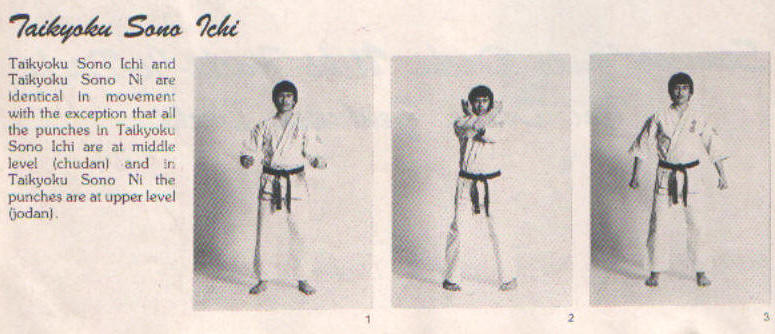  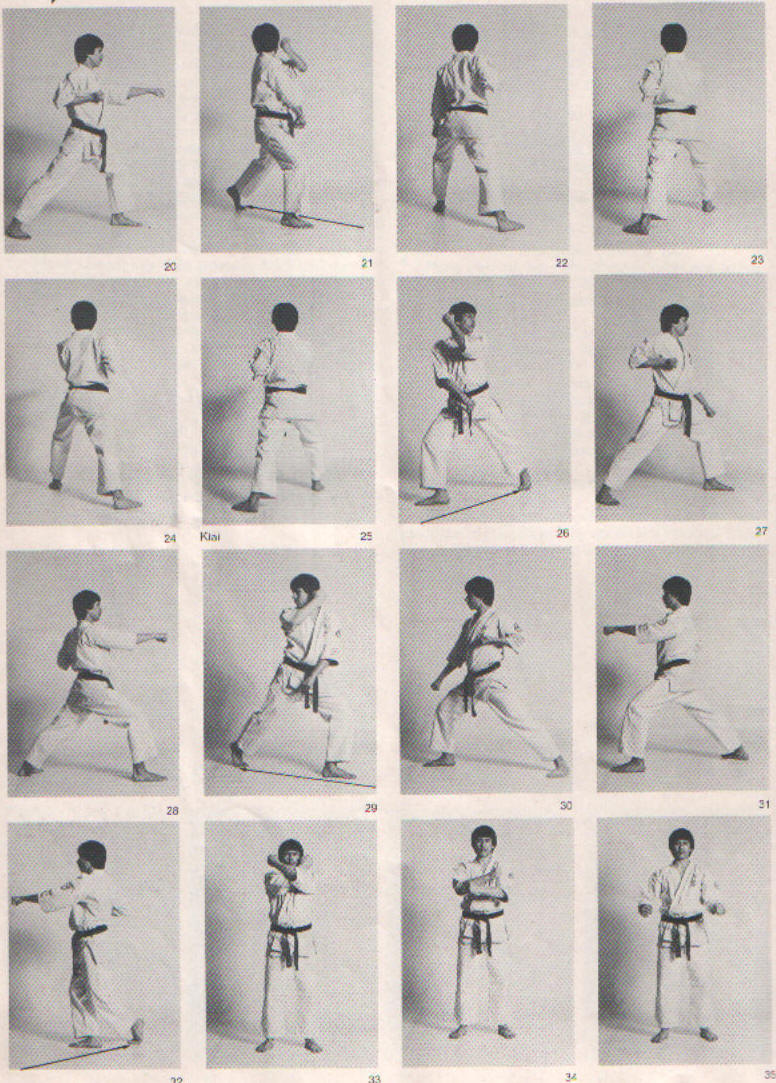 |
![]()
Below you will find all of what you need to know for your grading. It was designed to supply the students with information about their requirements for their grades. If you have any question regarding the requirements consult your teacher. The grading requirements in our school contain the following:
9th KYU:
Training Time = 9.5 months (one class per week/2 hrs. class)
Theory: (including all the above)
| Students must know the previous syllabuses) | |
| Summary of Karate History | |
| Summary of Kyokushin History |
| 25Hands Push Ups | |
| 15 Knuckle Push Ups | |
| 25 Deep Knee Bends With Front Kick | |
| 3 Min. Jump Rope | |
| 20 Sit Ups |
| Musubi Dachi (Meditation stance) | |
| Kokutso Dachi (Back leaning stance) | |
| Kiba Dachi (Horse stance / 90º and 45º) |
2) Tsuki Waza: (Punches - Strikes)
| Uraken Sayu Uchi (Backfist strike to the side) | |
| Shita Tsuki (Upper cut) | |
| Jodan Hiji Ate (Elbow strike to the head) | |
| Chudan Hiji Ate (Mid-level elbow strike) | |
| Shuto Ganmen Uchi (Knife hand strike to the face) |
| Seiken Chudan Uchi-Uke (Middle Inside block) | |
| Seiken Chudan Soto-Uke (Middle Outside block) | |
| Seiken Mawashi Gedan Barai (Lower roundhouse block) |
| Uchi Mawashi Geri Haisoku (Inside roundhouse kick) | |
| Soto Mawashi Geri Teisoku (Outside roundhouse kick) |
5) Katas: (Forms)
| Taikyoku Sono Ichi (Movie, 1 Camera Movie, 3 Camera) | |
| Taikyoku Sono Ni (Movie, 1 Camera Movie, 3 Camera) |
6) Idogeiko: (Basic Moving)
| Uraken Sayu Uchi (Going forward in Kiba Dachi) | |
| Shita Tsuki (Going forward in Zenkutsu Dachi) | |
| Jodan Hiji Ate (Going forward in Zenkutsu Dachi & Kokutso Dachi) | |
| Chudan Hiji Ate (Going forward in Zenkutsu Dachi & Kokutso Dachi) | |
| Shuto Ganmen Uchi (Going forward in Zenkutsu Dachi & Kokutso Dachi) | |
| Uchi Mawashi Geri Haisoku (Going forward in Zenkutsu Dachi) | |
| Soto Mawashi Geri Teisoku (Going forward in Zenkutsu Dachi) |
6) Goshin Jitsu: (Self Defense)
| Sanbon Kumite
(Three-step sparring) : Sanbon Kumite #5 Attacker: Seiken Jodan Oi Tsuki-migi Defender: Seiken Jodan Gyaku Uke-migi & Seiken Chudan Oi Tsuki-hidari) Sanbon Kumite #6 Attacker: Seiken Chudan Oi Tsuki-migi Defender: Seiken Chudan Uchi Gyaku Uke-migi & Seiken Chudan Oi Tsuki-hidari ) Sanbon Kumite #7 Attacker: Seiken Gedan Oi Tsuki-migi Defender: Seiken Gedan Gyaku Uke-migi & Seiken Jodan Oi Tsuki-hidari Sanbon Kumite #8 Attacker: Seiken Chudan Oi Tsuki-migi Defender: Seiken Soto Gyaku Uke-migi & Seiken Chudan Oi Tsuki-hidari | |
| Ippon Kumite :
Basic punches and blocks (Jodan, Chudan, Gedan). Use basic counterattacking. | |
| Basic Release
Techniques : Use all the basic block to release wrist grabs. | |
| Gyakute (Grappling,
Wrestling, Joint locking) Not required at this level. however it is important the students learn and understand at this level the following: 1.- Be able to recognize and avoid dangerous places and dangerous People |
7)
Kumite: ( Sparring ) :
1.-
Minimum of two Sparring of 2 minutes.
The students should be able to execute the techniques using any of the
stances. Also the students would be tested on any techniques from previous belt.
![]()
Karate appears fearful and destructive to many people. Movies have contributed to popularizing Karate in the wrong way. There are also many people who think that Karate is only a type of calisthenics or, perhaps, even a type of dance. This shows undeniably the lack of a proper view of what Karate really is.
Karate is a martial art, for many people it is a way of life, and it shares the common aim with Judo, Kendo, Aikido, the tea ceremony, calligraphy, and Japanese flower arranging of cultivating through physical and spiritual training. It is also within reason to claim that Karate, as the original martial art, through physical and spiritual training and discipline, makes the impossible possible, even to the unarmed, and helps one in pursuing the aim of his life. A physical training so strict naturally involves a demanding psychological training as well. Karate is a method of unifying the body and spirit and of making human life at once broader and deeper.
"Karate" is a combination of two Japanese words, "Kara" meaning empty or open and "Te", meaning hand, and is therefore used to describe a style of unarmed combat. Karate not always had this meaning of empty hands, this modern phrase started in a meeting of the Okinawan masters sponsored by an Okinawan newspaper, at which the use of the T'ang character in the word Karate was discussed. The ideograph for Kara was altered to erase the Chinese connection for political reasons. So, the character " T'ang" (Kara) was replaced for "Empty" (Kara).
It is generally accepted that the origins of karate are to be found in India(525 A.D.). The credit is given to a Buddhist priest named Daruma Taishi,also known as Bohdidharma, who was the third child of a king and a brilliant student of Zen. Daruma studied the attacking techniques of animals and insects and the forces of nature, and, combining these with a special breathing technique, he created the basis for a legendary system of weaponless fighting and mental concentration. Daruma created in China the Shao-Lin temple in the province of Honan and in that monastery he instructed other monks in his particular style of unarmed combat.
The system developed at the temple gradually disseminated throughout Asia, spreading to Okinawa, Korea and Mongolia. By 1130 A.D., aspects of this system had even been incorporated into the indigenous military disciplines of geographically and culturally isolated Japan.
The Asia fighting arts were historically taught and refined in secrecy, as their practice was routinely prohibited in different regions. Consequently, various regionally and family-based styles and schools evolved, one of these being the Kempo style of Okinawa.
By 1901, Kempo was being taught openly in Okinawa, and in 1916, was demonstrated in Japan by master Gichin Funakoshi. There, under the name of Karate, practical applications of the system were further refined and united with the Zen-based philosophy of the Japanese disciplines. The popularity of Karate as both a martial art and a sport spread quickly in Japan and beyond, contributing to the development of diverse systems and schools.
The principles and values of Karate, such as patience, concentration, respect and courtesy, are completely transferable and universally applicable to our daily affairs in business and at home. When the practitioner is able to apply and transfer those principles learned in Karate to their daily life then it become a practitioner of a Karate-Do, a way of life.
![]()
1923
Masutatsu Oyama, the founder of Kyokushin Karate was born in South Korea. Later,
he become Kancho of the International Karate
Organization, Kyokushin-kaikan.
1935
Masutatsu Oyama became a Black Belt (Shodan) in Shaku-riki system,
which is a form of Kempo called Eighteen Techniques, practiced in the
South part of China.At the age of nine, he started studying the Southern
Chinese form of Kempo called Eighteen Techniques (Shaku-riki system). Also
during this time until the age of 13, he studied a Korean Martial art
known as Taiken or Chabi. These Korean Arts were a mixture of Kempo,
which was similar to kung fu, and Ju Jitsu
1938
Mas.Oyama, moved to Tokyo, Japan and entered Yamanashi Youth Aviation Institute.
Studied Karate under Gichin Funakoshi, one of the first three to bring Karate
to Japan.
1946
Mas. Oyama went to Mt.Minobu for training.
1947
Mas. Oyama entered the First All Japan Tournament since the war; he became
champion.
1948
Mas. Oyama did 18 months of training alone on Mt. Kiyosumi in Chiba to perfect
his techniques and form his Karate way.
1953
Traveled to USA, where he fought with a bull in Chicago and became popular by
fighting with bulls.
1954
Opened his first dojo in Mejiro, Tokyo. The instructors were K.Mizushima and
E.Yasuda.
1956
The Oyama dojo was started in a small studio behind Rikkyo University. This dojo
was the beginning of the Kyokushinkaikan, the beginning of a Karate based on the
principle: 1000 days of training a beginner, 10000 days of training, a glimpse
of the mysteries.
1959
The first Hawaii Tournament.
1963
Construction of Kyokushinkai Honbu in Ikebukuro, Tokyo.
1964
Tokyo Honbu was officially opened, and the I.K.O was opened.
1966
The USA I.H.O. and the South American I.K.O. was founded.
1968
The European I.K.O. was established, and the Middle East I.K.O. was started.
Also the South Pacific I.K.O. was founded.
1969
The South African I.K.O. and the South East Asia were started.
1969
The first Japan Open Karate Tournament was held in
Tokyo; there were 48 competitors.
1970
The 2nd All Japan Open Karate Tournament was held.
1971
The 3rd All Japan Open Karate Tournament was held.
1972
The 4th All Japan Open Karate Tournament was held in Tokyo.
1973
Sosai Oyama visited many Branches throughout the world in connection with staging a
World Tournament two years later. The 5th All Japan Open Karate Tournament was
held.
1974
The 6th All Japan Open Karate Tournament was held in Tokyo.
1975
The First World Open Karate Tournament was held in Tokyo. 128 competitors
attended from 36 countries. Katsuaki Sato was the first World Champion.
1976
The First World Tournament movie “The Strongest Karate” was realized and
gained great popularity. The 8th All Japan Open Karate Tournament was held.
Later this year “The Strongest Karate Part 2” was realized.
1977
A South African Tournament was held. The 9th All Japan Open Karate Tournament
was held.
1978
Summer trainings camps were held in various countries around the world. The 1st
European Tournament was held in London. The 10th All Japan Open Karate
Tournament was held.
1979
The start of many tournaments around the world for selection of teams to attend
the 2nd World Open Karate Tournament of this year. Makoto Nakamura was the World
Champion. The British Tournament and the 11th All Japan Open Karate Tournament
were held.
1983
The 3rd World Open Karate Tournament was held. Makoto Nakamura was the World
Champion.
1987
The 4th World Open Karate Tournament was held. Around 70 countries with 200
competitors participated in this tournament. Akiyoshi Matsui was the World
Champion.
1991
The 5th World Open Karate Tournament was held. Over 110 countries with 250
competitors participated in this tournament. Kenji Midori was the World
Champion.
1994
Mas Oyama died leaving behind a very strong organization and a legacy called
Kyokushin Karate.
![]()
STANCES AND WEIGHT
DISTRIBUTIONS (DACHI)
|
|
|
|
STRIKES WITH THE BACK OF THE FISTS
(Uraken)
|
|
|
Uraken Sayu Uchi (In Kiba Dachi) |
STRIKES WITH FISTS; ELBOWS & KNIFE HAND
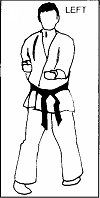 |
 |
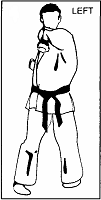 |
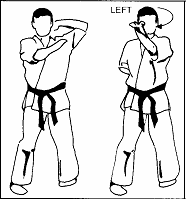 |
| SHITA TSUKI | CHUDAN HIJI ATE | JODAN HIJI ATE | SHUTO GANMEN UCHI |
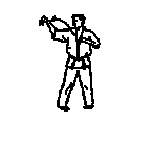 |
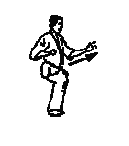 |
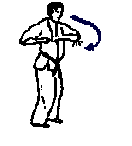 |
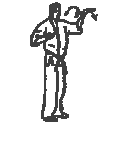 |
| URAKEN SAYU UCHI | SHITA TSUKI | CHUDAN HIJI ATE | SHUTO GANMEN UCHI |
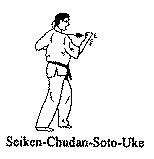 |
 |
| Seiken Chudan Soto Uke | Seiken Chudan Soto Uke |
 |
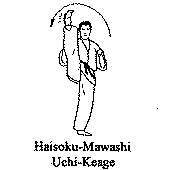 |
|
Also called |
Also called |
![]()
For more information contact your teacher, sensei Angel Carrasco at: angel@kyokushincanada.com
GO TO
THE MAIN PAGE OF WINNIPEG KYOKUSHIN KARATE - DOJO ENTHEOS